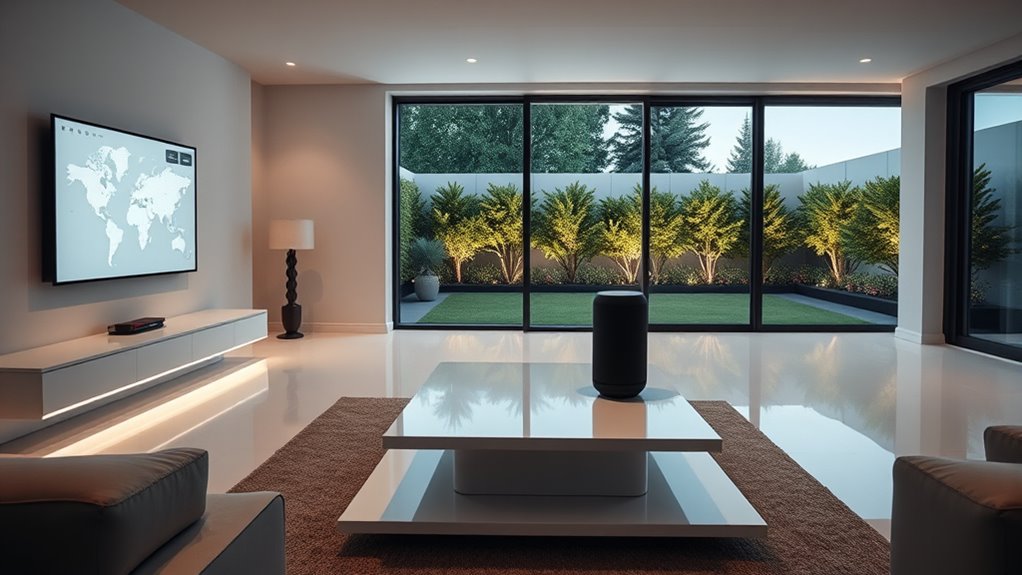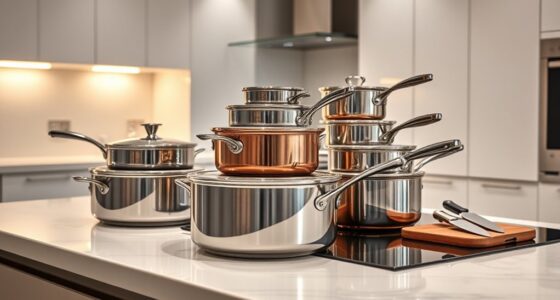Investing in a whole-home automation system can boost your home’s efficiency, security, and convenience by simplifying control over lighting, climate, and security with voice commands or a single device. While the upfront costs are significant, long-term savings on energy bills and increased property value can make it worthwhile. However, consider security risks and compatibility issues. To discover if this upgrade fits your lifestyle and budget, explore the full picture further.
Key Takeaways
- Whole-home automation enhances convenience, energy efficiency, and security through centralized control and personalized settings.
- Initial costs are high, but long-term savings and increased home value can offset expenses.
- Compatibility and future-proofing are crucial for seamless device integration and system upgrades.
- Privacy and security concerns require strong cybersecurity measures to prevent hacking and unauthorized access.
- The decision depends on balancing automation benefits with costs, security risks, and personal priorities.
Benefits of Whole-Home Automation

Whole-home automation offers numerous advantages that can simplify your daily life and enhance comfort. With smart home integration, you can control lighting, climate, security, and appliances from a single device or voice command, making daily routines more seamless. This integration also allows for customized settings that adapt to your preferences, further personalizing your living experience. This technology also boosts energy efficiency by automatically adjusting thermostats, turning off unused devices, and optimizing lighting based on your habits. This can lead to significant energy savings over time. Water resistance features in some devices ensure reliable performance even in adverse weather conditions. As a result, you save money on energy bills while reducing your environmental impact. Automation systems can alert you to issues like leaks or security breaches, giving you peace of mind. Additionally, advancements in sound design technology have made it possible to create more immersive and intuitive user experiences within smart homes. Incorporating reliable power sources into your automation setup ensures continuous operation during outages, further enhancing your home’s resilience. Overall, investing in whole-home automation makes your home smarter, more responsive, and more efficient—turning your living space into a convenient, eco-friendly haven.
Financial Considerations and Costs
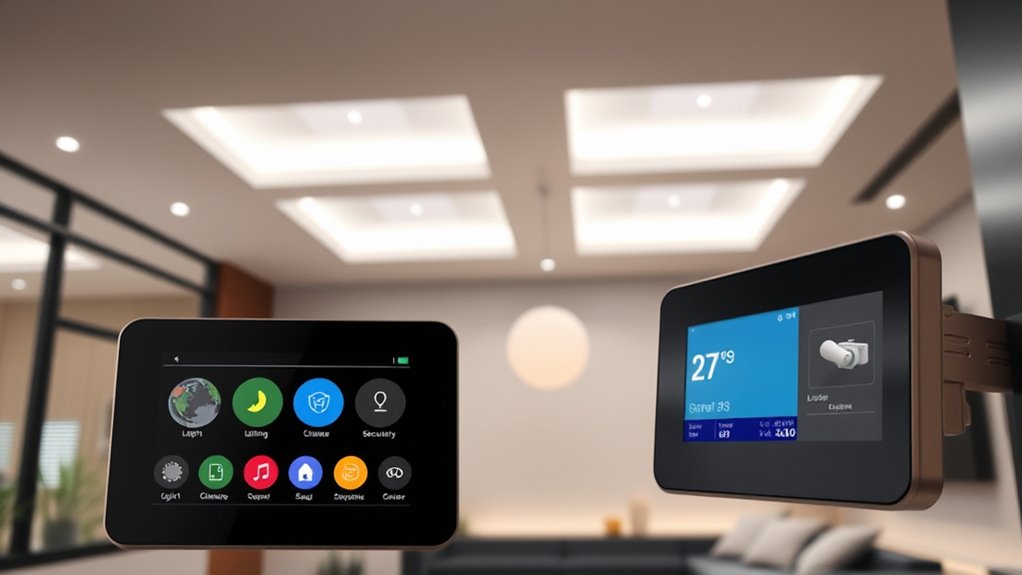
Implementing whole-home automation involves significant upfront costs, so it’s important to carefully consider your budget. A thorough cost analysis helps you understand the expenses associated with equipment, installation, and ongoing maintenance. You should evaluate different systems and providers to find options that fit within your financial means. Budget planning is essential—determine how much you’re willing to invest upfront and over time. Keep in mind that while initial costs can be high, some systems may reduce energy bills and increase home value, offering long-term savings. Balancing your desired features with your budget ensures you make a smart investment. Carefully evaluating costs now can prevent surprises later and help you decide if a whole-home automation system aligns with your financial goals. Additionally, understanding the upfitting fundamentals can assist in choosing scalable solutions that meet your needs without exceeding your budget. Considering networking hardware and infrastructure options ensures your system remains reliable and adaptable as your needs evolve. Incorporating energy-efficient devices can further optimize your investment by reducing ongoing operating costs. Exploring cost-effective options can help you identify features that deliver value without overspending. Moreover, selecting systems with integrated security features can provide added peace of mind and protect your investment over time.
Technological Features and Compatibility

Choosing the right technological features for your home automation system depends on guaranteeing device compatibility among various devices and platforms. You want seamless integration, so your smart lights, thermostats, and security cameras work together effortlessly. Voice control is a popular feature that enhances convenience, but it only works if your devices support compatible voice assistants like Alexa, Google Assistant, or Siri. Before purchasing, verify device compatibility to avoid frustration later. It is also important to consider the technology standards that ensure future-proofing and interoperability across brands. Ensuring standardized communication protocols can facilitate easier upgrades and device additions in the future. Compatibility also means choosing a platform that supports a broad range of products, so your system can grow with your needs. Additionally, verifying the software update process can help maintain system security and performance over time. Incorporating interoperability features can further improve the overall user experience by allowing devices from different manufacturers to work harmoniously. Focusing on these aspects ensures your smart home is both functional and scalable.
Privacy and Security Concerns
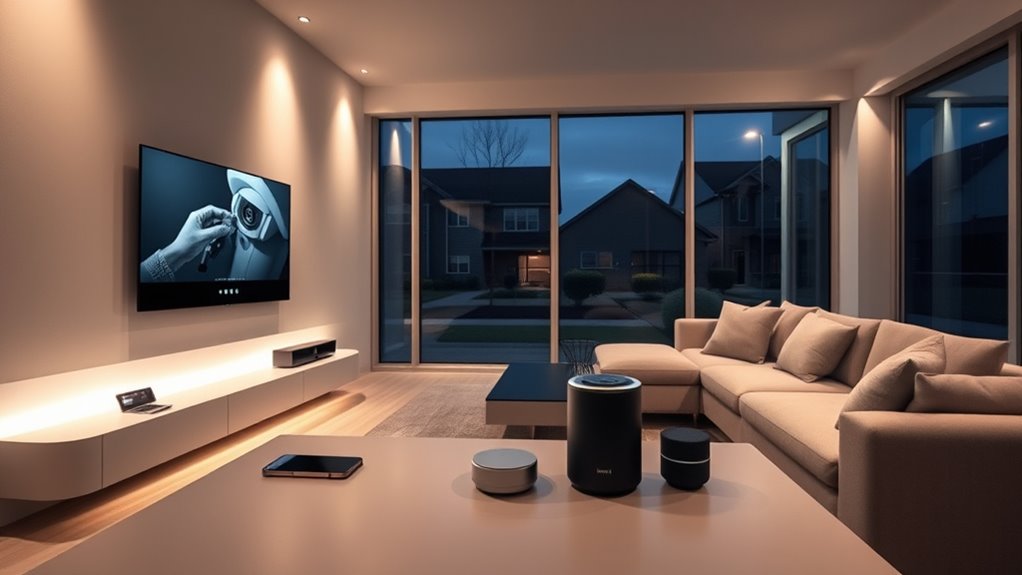
Have you ever considered how vulnerable your smart home devices might be to cyber threats? With interconnected systems collecting data and controlling your appliances, there’s a real concern about data privacy. Hackers can exploit vulnerabilities, potentially gaining access to personal information or even your security cameras. Hacking risks increase if devices lack proper security measures or updates. It’s essential to understand that a breach not only compromises your privacy but could also lead to unauthorized control over your home’s systems. Protecting your data privacy involves using strong passwords, enabling two-factor authentication, and regularly updating device firmware. Being aware of these risks helps you make informed decisions about your home automation setup and take steps to minimize potential security threats. Additionally, understanding the security vulnerabilities associated with connected devices emphasizes the importance of implementing comprehensive cybersecurity measures. Recognizing the potential for cyber attacks can motivate homeowners to adopt stronger security practices and safeguard their smart homes. Staying informed about merchant services and their evolving security standards can further help in protecting your connected home environment. Regularly reviewing your device security settings is also crucial in maintaining a secure smart home ecosystem. Given the rise of AI algorithms analyzing behavior patterns, ensuring your devices are resilient against adaptive cyber threats is increasingly vital.
Making the Decision: Is It Worth the Investment?
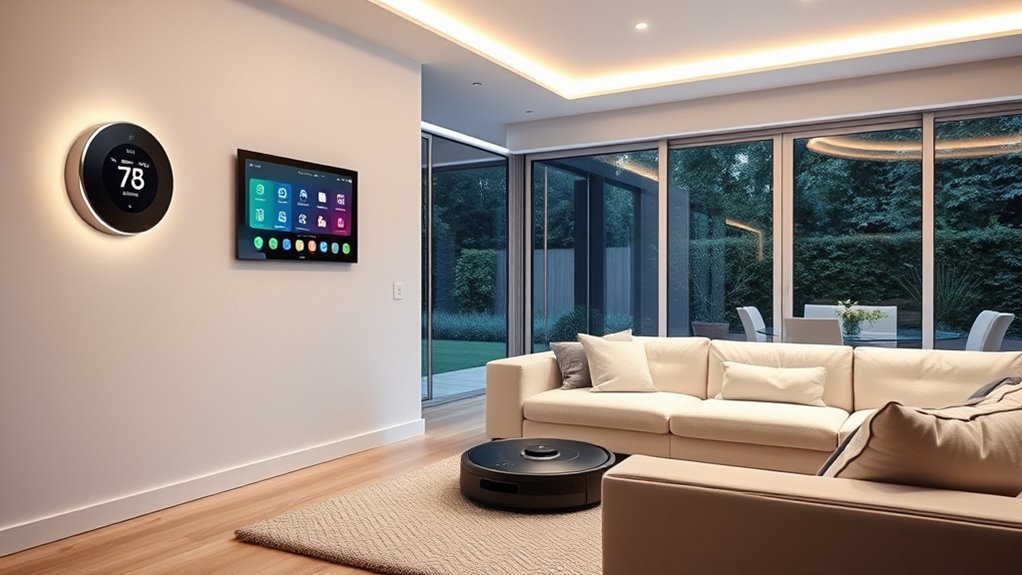
Deciding whether investing in a smart home system is worthwhile depends on weighing the benefits against the costs and potential risks. A user interface that’s intuitive and easy to navigate can make managing your system straightforward, enhancing daily convenience. Consider the energy savings—smart systems optimize your home’s energy use, reducing bills over time. Additionally, integrating home automation features can improve your home’s overall security and functionality. However, you should also evaluate the upfront costs and ongoing maintenance. If you value enhanced control, security, and long-term savings, the investment may be justified. It’s also important to assess the security vulnerabilities associated with connected devices, which could pose privacy concerns. Some systems include local automation options that help mitigate external vulnerabilities, providing more control over your data. Moreover, understanding alimony laws and their implications can be crucial if your decision to upgrade involves shared property or assets. On the other hand, if the costs outweigh the benefits or you’re concerned about security vulnerabilities, it might be less appealing. Ultimately, your decision hinges on how much you prioritize automation’s convenience and efficiency versus the initial financial commitment.
Frequently Asked Questions
How Long Does It Typically Take to Install a Whole-Home Automation System?
Installation typically takes between one to three days, depending on your home’s size and complexity. During this process, your installer will assess your needs, customize options, and set up the system efficiently. Smaller homes may be ready sooner, while larger, more complex setups require extra time for thorough integration. You’ll want to plan ahead, so your system is fully operational and tailored to your preferences without unnecessary delays.
Can Existing Homes Easily Be Upgraded With Automation Features?
Upgrading your existing home with automation features is quite straightforward. You can easily add smart lighting to customize your ambiance, install security cameras for enhanced safety, and integrate voice control for convenience. Many systems are designed for retrofit, meaning they adapt to your current setup without major renovations. With a little planning, you’ll quickly enjoy the benefits of a more connected, secure, and efficient home.
What Are the Most Common Technical Issues Faced by Users?
You might face issues with wireless connectivity, causing devices to disconnect or lag. Voice command accuracy can also be a problem, leading to frustration if your system misinterprets your requests or doesn’t respond promptly. Regular updates and strong Wi-Fi signals help, but you should still expect occasional glitches. Staying patient and troubleshooting connectivity or voice recognition issues guarantees your smart home runs smoothly and enhances your overall experience.
How Do Automation Systems Handle Power Outages or System Failures?
When the lights go out, your automation system isn’t left in the dark. You’re covered with backup power options and system redundancy, ensuring your smart home keeps running smoothly. These systems often switch seamlessly to backup power sources, like generators or batteries, and have redundancy measures in place so critical functions stay operational. You won’t have to worry about outages causing chaos—you’re in control, rain or shine.
Are There Any Ongoing Maintenance Requirements for These Systems?
Yes, there are ongoing maintenance requirements for your home automation system. You need to monitor energy consumption to guarantee efficiency and avoid unnecessary costs. Regularly installing software updates keeps your system secure and running smoothly, preventing vulnerabilities. Additionally, check sensors and devices periodically for proper functioning. This proactive maintenance helps maximize your system’s benefits and minimizes potential issues, ensuring your smart home remains reliable and efficient.
Conclusion
Ultimately, investing in a whole-home automation system is a big leap, but it’s not a decision to take lightly. If you weigh the benefits against costs and consider your privacy, you’ll see whether it’s worth the gamble. Think of it like planting a seed—you’ll need patience and care to see it flourish. When all parts align, your smart home can truly become a game-changer, making everyday living smoother and more efficient.
